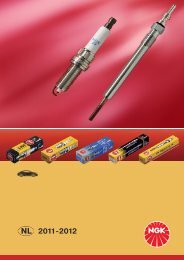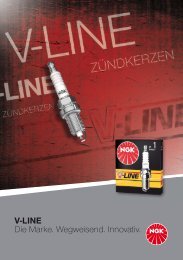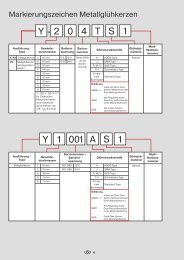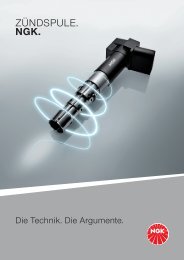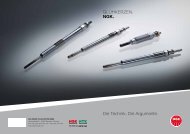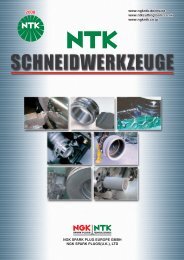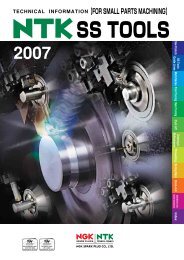- Page 1 and 2:
2012 - 2013
- Page 3 and 4:
The spark plugs, glow plugs, and ca
- Page 5 and 6:
Tightening torques for spark plugs
- Page 7 and 8:
Symbols used on spark plugs The sta
- Page 9 and 10:
Symbols used on metal glow plugs Sh
- Page 11 and 12:
V-Line - a sales concept with many
- Page 13 and 14:
V-Line V-Line No. 25 NGK has develo
- Page 15 and 16:
V-Line overview V-Line Type Automob
- Page 17 and 18:
LPG LaserLine - the best for gas op
- Page 19 and 20:
LPG LaserLine - Optimum market cove
- Page 21 and 22:
Ceramic glow plugs As opposed to a
- Page 23 and 24:
2012-2013 NGK racing spark plugs CY
- Page 25 and 26:
CYP 23
- Page 27 and 28:
apalovací, žhavicí svíčky a sv
- Page 29 and 30:
Utahovací momenty zapalovacích sv
- Page 31 and 32:
Označení zapalovacích svíček Z
- Page 33 and 34:
Označení kovových žhavicích sv
- Page 35 and 36:
V-Line - koncepce prodeje s mnoha v
- Page 37 and 38:
V-Line V-Line č. 25 Pro modely FOR
- Page 39 and 40:
Přehled V-Line V-Line Typ Výrobci
- Page 41 and 42:
LPG LaserLine - to nejlepší pro m
- Page 43 and 44:
LPG LaserLine - optimální pokryt
- Page 45 and 46:
Keramické žhavicí svíčky Na ro
- Page 47 and 48:
2012-2013 Závodní zapalovací sv
- Page 49 and 50:
CZ 23
- Page 51 and 52:
Die im Katalog aufgeführten Zünd
- Page 53 and 54:
Drehmomente Zündkerzen Das richtig
- Page 55 and 56:
Markierungszeichen Zündkerzen Die
- Page 57 and 58:
Markierungszeichen Metallglühkerze
- Page 59 and 60:
V-Line - ein Verkaufskonzept mit vi
- Page 61 and 62:
V-Line Die V-Line Nr. 25 Für FORD-
- Page 63 and 64:
V-Line Übersicht V-Line Type Fahrz
- Page 65 and 66:
LPG LaserLine - das Beste für gasb
- Page 67 and 68:
LPG LaserLine - Optimale Marktabdec
- Page 69 and 70:
Keramikglühkerzen Im Gegensatz zu
- Page 71 and 72:
2012-2013 NGK RACING SPARK PLUGS D
- Page 73 and 74:
D 23
- Page 75 and 76:
De tændrør, gløderør og tændr
- Page 77 and 78:
Omdrejningsmomenter tændrør Det r
- Page 79 and 80:
Markeringstegn tændrør Standard-t
- Page 81 and 82:
Markeringstegn metalstartgløderør
- Page 83 and 84:
V-Line - et salgskoncept med mange
- Page 85 and 86:
V-Line V-Line Nr. 25 Til Ford-model
- Page 87 and 88:
V-Line Oversigt V-Line Type Køret
- Page 89 and 90:
NY: LPG LaserLine - det bedste til
- Page 91 and 92:
LPG LaserLine - Optimal dækning af
- Page 93 and 94:
Keramiske gløderør Modsat et meta
- Page 95 and 96:
2012-2013 NGK Racertændrør DK 21
- Page 97 and 98:
DK 23
- Page 99 and 100:
Los errores reconocibles, como los
- Page 101 and 102:
Pares de apriete Bujías de encendi
- Page 103 and 104:
Símbolos de diseño Bujías de enc
- Page 105 and 106:
Marca de seguridad Bujías de incan
- Page 107 and 108:
V-Line: un concepto de venta con mu
- Page 109 and 110:
V-Line V-Line N° 25 NGK desarroll
- Page 111 and 112:
Visión de conjunto V-Line V-Line T
- Page 113 and 114:
LPG LaserLine - la mejor solución
- Page 115 and 116:
LPG LaserLine - La mejor cobertura
- Page 117 and 118:
Calentadores de cerámica Al contra
- Page 119 and 120:
2012-2013 Bujías de competición N
- Page 121 and 122:
E 23
- Page 123 and 124:
Käesolevast kataloogist leiate sü
- Page 125 and 126:
Süüteküünalde pöördemomendid
- Page 127 and 128:
Süüteküünalde märgistused Siin
- Page 129 and 130:
Metallist hõõgküünalde märgist
- Page 131 and 132:
V-Line - mitme eelisega müügikont
- Page 133 and 134:
V-Line V-Line nr. 25 Fordi mudelite
- Page 135 and 136:
V-Line ülevaade V-Line Tüüp Sõi
- Page 137 and 138:
LPG LaserLine - parim küünal gaas
- Page 139 and 140:
LPG LaserLine - turuvajaduste optim
- Page 141 and 142:
Keraamilised hõõgküünlad Erinev
- Page 143 and 144:
2012-2013 NGK võidusõidu-süütek
- Page 145 and 146:
EST 23
- Page 147 and 148:
Luettelossa mainittuja sytytystulpp
- Page 149 and 150:
Sytytystulppien kiristysmomentit Ki
- Page 151 and 152:
Sytytystulppien merkinnät Käytös
- Page 153 and 154:
Metallisten hehkutulppien merkinnä
- Page 155 and 156:
V-Line - menestysresepti sisältä
- Page 157 and 158:
V-Line V-LINE NRO 25 FORDIN malleih
- Page 159 and 160:
V-Line, yleistiedot V-Line Tyyppi A
- Page 161 and 162:
UUSI: LPG LaserLine - paras kaasuk
- Page 163 and 164:
LPG LaserLine - Optimaaliset sovelt
- Page 165 and 166:
Keraamiset hehkutulpat Toisin kuin
- Page 167 and 168:
2012-2013 NGK-kilpasytytystulpat FI
- Page 169 and 170:
FIN 23
- Page 171 and 172:
Les bougies d’allumage, bougies d
- Page 173 and 174:
Couples de serrage Bougies d’allu
- Page 175 and 176:
Repères Bougies d’allumage La d
- Page 177 and 178:
Repères Bougies de préchauffage m
- Page 179 and 180:
V-Line - un concept de vente qui pr
- Page 181 and 182:
V-Line Die V-Line No. 25 Pour les m
- Page 183 and 184:
Récapitulatif V-Line V-Line Type C
- Page 185 and 186:
LPG LaserLine - Le top pour des mot
- Page 187 and 188:
LPG LaserLine - Couverture optimum
- Page 189 and 190:
Bougies de préchauffage en cérami
- Page 191 and 192:
2012-2013 Bougies d'allumage de cou
- Page 193 and 194:
F 23
- Page 195 and 196:
The spark plugs, glow plugs, and ca
- Page 197 and 198:
Tightening torques for spark plugs
- Page 199 and 200:
Symbols used on spark plugs The sta
- Page 201 and 202:
Symbols used on metal glow plugs Sh
- Page 203 and 204:
V-Line - a sales concept with many
- Page 205 and 206:
V-Line V-Line No. 25 NGK has develo
- Page 207 and 208:
V-Line overview V-Line Type Automob
- Page 209 and 210:
LPG LaserLine - the best for gas op
- Page 211 and 212:
LPG LaserLine - Optimum market cove
- Page 213 and 214:
Ceramic glow plugs As opposed to a
- Page 215 and 216:
2012-2013 NGK racing spark plugs GB
- Page 217 and 218: GB 23
- Page 219 and 220: Τα γπυί, ι πρθερμάν
- Page 221 and 222: Ροπές σύσφιξης μπο
- Page 223 and 224: Σήμα μαρκαρίσματος
- Page 225 and 226: Σήμα μαρκαρίσματος
- Page 227 and 228: V-Line - ένα σχέδιο πωλ
- Page 229 and 230: V-Line V-Line No. 25 Για μντ
- Page 231 and 232: Σύνοψη V-Line V-Line Τύπο
- Page 233 and 234: LPG LaserLine - ότι καλύτε
- Page 235 and 236: LPG LaserLine - Ιδανική κά
- Page 237 and 238: Κεραμικοί προθερμα
- Page 239 and 240: 2012-2013 Αγωνιστικά μπ
- Page 241 and 242: GR 23
- Page 243 and 244: A katalógusunkban felsorolt gyújt
- Page 245 and 246: Gyújtógyertyák nyomatékai A gy
- Page 247 and 248: Gyújtógyertyák jelzései Itt lá
- Page 249 and 250: Fém gyújtógyertyák jelzései R
- Page 251 and 252: V-Line - eladási koncepció, sok e
- Page 253 and 254: V-Line V-Line No. 25 A ZETEC motorr
- Page 255 and 256: V-Line áttekintés V-Line Típus J
- Page 257 and 258: LPG LaserLine - a legjobb agázüze
- Page 259 and 260: LPG LaserLine - optimális piaci fe
- Page 261 and 262: Kerámia izzítógyertyák A fémru
- Page 263 and 264: 2012-2013 NGK versenygyertyák H 21
- Page 265 and 266: H 23
- Page 267: The spark plugs, glow plugs, and ca
- Page 271 and 272: Symbols used on spark plugs The sta
- Page 273 and 274: Symbols used on metal glow plugs Sh
- Page 275 and 276: V-Line - a sales concept with many
- Page 277 and 278: V-Line V-Line No. 25 NGK has develo
- Page 279 and 280: V-Line overview V-Line Type Automob
- Page 281 and 282: LPG LaserLine - the best for gas op
- Page 283 and 284: LPG LaserLine - Optimum market cove
- Page 285 and 286: Ceramic glow plugs As opposed to a
- Page 287 and 288: 2012-2013 NGK racing spark plugs IS
- Page 289 and 290: IS 23
- Page 291 and 292: Le candele di qualsiasi genere, ed
- Page 293 and 294: Coppie di serraggio candele Coppie
- Page 295 and 296: Marcature delle candele Qui è ripo
- Page 297 and 298: Marcature delle candelette con bulb
- Page 299 and 300: V-Line - un concetto di vendita con
- Page 301 and 302: V-Line V-Line N° 25 Per i modelli
- Page 303 and 304: Panoramica V-Line V-Line Tipi Costr
- Page 305 and 306: LPG LaserLine - dedicate ai motori
- Page 307 and 308: LPG LaserLine - ottima copertura di
- Page 309 and 310: Candelette con bulbo ceramico Rispe
- Page 311 and 312: 2012-2013 Candele Racing NGK I 21
- Page 313 and 314: I 23
- Page 315 and 316: The spark plugs, glow plugs, and ca
- Page 317 and 318: Tightening torques for spark plugs
- Page 319 and 320:
Symbols used on spark plugs The sta
- Page 321 and 322:
Symbols used on metal glow plugs Sh
- Page 323 and 324:
V-Line - a sales concept with many
- Page 325 and 326:
V-Line V-Line No. 25 NGK has develo
- Page 327 and 328:
V-Line overview V-Line Type Automob
- Page 329 and 330:
LPG LaserLine - the best for gas op
- Page 331 and 332:
LPG LaserLine - Optimum market cove
- Page 333 and 334:
Ceramic glow plugs As opposed to a
- Page 335 and 336:
2012-2013 NGK racing spark plugs M
- Page 337 and 338:
M 23
- Page 339 and 340:
De bougies, gloeibougies en bougied
- Page 341 and 342:
Aandraaimomenten bougies Aandraaimo
- Page 343 and 344:
Markeringstekens bougies De standaa
- Page 345 and 346:
Markeringsteken metalen gloeibougie
- Page 347 and 348:
V-Line - een verkoopconcept met vel
- Page 349 and 350:
V-Line V-Line 25 NGK heeft een dubb
- Page 351 and 352:
V-Line overzicht V-Line Type Voertu
- Page 353 and 354:
LPG LaserLine - het beste voor auto
- Page 355 and 356:
LPG LaserLine - ottima copertura di
- Page 357 and 358:
Keramische gloeibougies In tegenste
- Page 359 and 360:
2012-2013 NGK racebougies NL 21
- Page 361 and 362:
NL 23
- Page 363 and 364:
De tennplugger, glødeplugger og pl
- Page 365 and 366:
Dreiemomenter tennplugger Det rikti
- Page 367 and 368:
Markeringstegn tennplugger Her er s
- Page 369 and 370:
Markeringstegn metallglødeplugger
- Page 371 and 372:
V-Line - et salgskonsept med mange
- Page 373 and 374:
V-Line V-Line N° 25 For FORD-model
- Page 375 and 376:
V-Line oversikt V-Line Type Kjøret
- Page 377 and 378:
NY: LPG LaserLine - det beste for g
- Page 379 and 380:
LPG LaserLine - Optimal markedsdekn
- Page 381 and 382:
Keramikk glødeplugger I motsetning
- Page 383 and 384:
2012-2013 NGK racetennplugger N 21
- Page 385 and 386:
N 23
- Page 387 and 388:
Świece zapłonowe, świece żarowe
- Page 389 and 390:
Momenty dokręcenia świec zapłono
- Page 391 and 392:
Oznakowania świec zapłonowych Tut
- Page 393 and 394:
Oznakowanie świec żarowych metalo
- Page 395 and 396:
V-Line - koncepcja sprzedaży z wie
- Page 397 and 398:
V-Line V-Line Nr. 25 Dla modeli FOR
- Page 399 and 400:
PrzeglądV-Line V-Line Typ Producen
- Page 401 and 402:
LPG LaserLine - najlepsze dla silni
- Page 403 and 404:
LPG LaserLine - optymalne pokrycie
- Page 405 and 406:
Świece żarowe ceramiczne Wprzeciw
- Page 407 and 408:
2012-2013 Świece zapłonowe sporto
- Page 409 and 410:
PL 23
- Page 411 and 412:
As velas de ignição, velas de res
- Page 413 and 414:
Binários Velas de ignição O torq
- Page 415 and 416:
Símbolos de identificação Velas
- Page 417 and 418:
Símbolos de identificação Velas
- Page 419 and 420:
A linha V -Um conceito comercial co
- Page 421 and 422:
V-Line V-Line N° 25 A NGK concebeu
- Page 423 and 424:
A Lina V em resumo V-Line Modelo Fa
- Page 425 and 426:
GLP LaserLine - la mejor solución
- Page 427 and 428:
GPL LaserLine - Uma cobertura optim
- Page 429 and 430:
Velas de incandescência cerâmicas
- Page 431 and 432:
2012-2013 Velas de competição NGK
- Page 433 and 434:
P 23
- Page 435 and 436:
, , , . ш
- Page 437 and 438:
Моменты затяжки св
- Page 439 and 440:
Маркировка свечей
- Page 441 and 442:
Маркировочные отме
- Page 443 and 444:
V-Line - концепция сбы
- Page 445 and 446:
V-Line V-Line 25 FORD, ZETEC,
- Page 447 and 448:
Обзор V-Line V-Line Тип П
- Page 449 and 450:
LPG LaserLine - идеальное
- Page 451 and 452:
LPG LaserLine - Оптимальн
- Page 453 and 454:
Керамические свечи
- Page 455 and 456:
2012-2013 Гоночные свеч
- Page 457 and 458:
RUS 23
- Page 459 and 460:
Alla tändstift, glödstift och tä
- Page 461 and 462:
Vridmoment tändstift Korrekt åtdr
- Page 463 and 464:
Markeringar tändstift Här finns s
- Page 465 and 466:
Markeringar glödstift av metall Ut
- Page 467 and 468:
V-Line - ett försäljningskoncept
- Page 469 and 470:
V-Line V-Line Nr. 25 NGK har utveck
- Page 471 and 472:
V-Line översikt V-Line Typ Fordons
- Page 473 and 474:
LPG LaserLine - bäst för gasdrivn
- Page 475 and 476:
LPG LaserLine - Optimal marknadstä
- Page 477 and 478:
Keramiska glödstift II motsats til
- Page 479 and 480:
2012-2013 NGK racertändstift S 21
- Page 481 and 482:
S 23
- Page 483 and 484:
Katalogda belirtilen bujiler, kızd
- Page 485 and 486:
Buji torkları Torklar Bir bujinin
- Page 487 and 488:
Buji işaretleme işaretleri Standa
- Page 489 and 490:
Metal akkor bujiler işaretleme iş
- Page 491 and 492:
V-Line -çok avantajlı satış kon
- Page 493 and 494:
V-Line V-Line Nr. 25 FORD’ un ZET
- Page 495 and 496:
ujiler tüm hatlarda avantaj sağla
- Page 497 and 498:
LPG LaserLine - Gazla çalışan mo
- Page 499 and 500:
LPG LaserLine - En yüksek pazar ih
- Page 501 and 502:
Seramik kızdırma bujileri Bir çu
- Page 503 and 504:
2012-2013 NGK yarış bujileri TR 2
- Page 505 and 506:
TR 23
- Page 518 and 519:
78 91 18 Y-102 M 10 x 1.25 12 Hex 1
- Page 520 and 521:
96 105,5 32,0 Y-118 R M 10 x 1.25 1
- Page 522 and 523:
101 Y-197 T M 10 x 1.25 12 Hex 23 V
- Page 524 and 525:
80 108 24,0 Y-405 M 14 x 1.25 17 He
- Page 526 and 527:
170 36 Y-531 J M 10 x 1.25 12 Hex 1
- Page 528 and 529:
90 73 24,5 Y-710 J M 10 x 1.25 12 H
- Page 530 and 531:
129 88 30,0 Y-746 J M 10 x 1.0 10 H
- Page 532 and 533:
60 115 20,0 Y-918 J M 12 x 1.25 12
- Page 534 and 535:
150 69 26,5 Y-8002 AS M 8 x 1.0 8 H
- Page 536 and 537:
89 84 22,0 CX 51 M 10 x 1.25 10 Hex
- Page 539 and 540:
Code kW Cyl. 500 1.4 T-Jet 16V 1.4
- Page 541 and 542:
Code kW Cyl. 147 2.0 T.S. 16V 2.0 1
- Page 543 and 544:
Code kW Cyl. 37 ALFA ROMEO GT GT 1.
- Page 545 and 546:
Code kW Cyl. ASTON MARTIN DB7 5.9 1
- Page 547 and 548:
Code kW Cyl. 41 AUDI A 3 2 A 3 (2)
- Page 549 and 550:
Code kW Cyl. 43 AUDI A 4 2 A 4 (2)
- Page 551 and 552:
Code kW Cyl. A 6 1 A 6 (1) 2.5 TDI
- Page 553 and 554:
Code kW Cyl. 47 AUDI A 6 4 A 6 (4)
- Page 555 and 556:
Code kW Cyl. 49 AUDI Q 7 Q 7 3.0 TD
- Page 557 and 558:
Code kW Cyl. BENTLEY Continental R
- Page 559 and 560:
Code kW Cyl. 3ER E46 320 d Touring
- Page 561 and 562:
Code kW Cyl. 5ER E34 535 i E34 3.5
- Page 563 and 564:
Code kW Cyl. 7ER E32 740 i E32 4.0
- Page 565 and 566:
Code kW Cyl. Lacrosse 3.6 05 - V6 2
- Page 567 and 568:
Code kW Cyl. 61 CHEVROLET EPICA Epi
- Page 569 and 570:
Code kW Cyl. 63 CHRYSLER VOYAGER 1
- Page 571 and 572:
Code kW Cyl. 65 CITROEN C15 C15 D 1
- Page 573 and 574:
Code kW Cyl. C5 C5 Hdi 2.2 98 09.04
- Page 575 and 576:
Code kW Cyl. 69 CITROEN SAXO 1 Saxo
- Page 577 and 578:
Code kW Cyl. 71 CITROEN ZX ZX 1.8 D
- Page 579 and 580:
Code kW Cyl. 73 DAEWOO TACUMA Tacum
- Page 581 and 582:
Code kW Cyl. DAIMLER 4.0 V8 4.0 03.
- Page 583 and 584:
Code kW Cyl. F430 Coupé / F430 Spi
- Page 585 and 586:
Code kW Cyl. CROMA 1 Croma Ti Turbo
- Page 587 and 588:
Code kW Cyl. MAREA Marea i.;80 16V
- Page 589 and 590:
Code kW Cyl. PUNTO Punto 16V 1.2L C
- Page 591 and 592:
Code kW Cyl. TIPO Tipo 1.1L 160 1.1
- Page 593 and 594:
Code kW Cyl. EXPLORER Explorer 4.0
- Page 595 and 596:
Code kW Cyl. 89 FORD FOCUS ´98 Foc
- Page 597 and 598:
Code kW Cyl. FUSION Fusion 1.25 JU
- Page 599 and 600:
Code kW Cyl. MONDEO ´97 Mondeo ´9
- Page 601 and 602:
Code kW Cyl. SCORPIO ´85 Scorpio
- Page 603 and 604:
Code kW Cyl. TRANSIT CONNECT Transi
- Page 605 and 606:
Code kW Cyl. 99 HONDA ACCORD AERO A
- Page 607 and 608:
Code kW Cyl. 101 HONDA CR-V CR-V 2.
- Page 609 and 610:
Code kW Cyl. 103 HYUNDAI ACCENT Acc
- Page 611 and 612:
Code kW Cyl. I40 i40 CW 1.7 CRDi 1.
- Page 613 and 614:
Code kW Cyl. 107 HYUNDAI TUCSON Tuc
- Page 615 and 616:
Code kW Cyl. XJ8 XJ8 3.2 09.98 - 03
- Page 617 and 618:
Code kW Cyl. LIBERTY Liberty 2.4 02
- Page 619 and 620:
Code kW Cyl. PICANTO (BA) Picanto 1
- Page 621 and 622:
Code kW Cyl. LADA (AVTOVAZ) 1200 1.
- Page 623 and 624:
Code kW Cyl. LADA (AVTOVAZ) Nova /
- Page 625 and 626:
Code kW Cyl. 119 LANCIA LYBRA Lybra
- Page 627 and 628:
Code kW Cyl. 121 LANCIA ZETA Zeta T
- Page 629 and 630:
Code kW Cyl. 123 LEXUS LS LS 400 4.
- Page 631 and 632:
Code kW Cyl. 125 MAZDA 3 3 (BK) 2.0
- Page 633 and 634:
Code kW Cyl. 127 MAZDA 626 626 (GE)
- Page 635 and 636:
Code kW Cyl. RX-8 RX-8 2.6 141 09.0
- Page 637 and 638:
Code kW Cyl. 131 MERCEDES C W/S 203
- Page 639 and 640:
Code kW Cyl. 133 MERCEDES CLK C208
- Page 641 and 642:
Code kW Cyl. 135 MERCEDES E W/S 210
- Page 643 and 644:
Code kW Cyl. 137 MERCEDES G W463 G
- Page 645 and 646:
Code kW Cyl. 139 MERCEDES S W140 S
- Page 647 and 648:
Code kW Cyl. 141 MERCEDES SLK R170
- Page 649 and 650:
Code kW Cyl. 143 MERCEDES VANEO 414
- Page 651 and 652:
Code kW Cyl. 145 MITSUBISHI ASX ASX
- Page 653 and 654:
Code kW Cyl. GALLOPER Galloper Td 2
- Page 655 and 656:
Code kW Cyl. 149 MITSUBISHI PAJERO
- Page 657 and 658:
Code kW Cyl. 151 NISSAN 100 NX 100
- Page 659 and 660:
Code kW Cyl. 153 NISSAN MICRA 2 Mic
- Page 661 and 662:
Code kW Cyl. 155 NISSAN PRIMASTAR P
- Page 663 and 664:
Code kW Cyl. 157 NISSAN SUNNY Sunny
- Page 665 and 666:
Code kW Cyl. ASTRA F Astra F 1.6 1.
- Page 667 and 668:
Code kW Cyl. CAMPO Campo 2.3 2.3 72
- Page 669 and 670:
Code kW Cyl. OPEL FRONTERA A Fronte
- Page 671 and 672:
Code kW Cyl. 165 OPEL SIGNUM Signum
- Page 673 and 674:
Code kW Cyl. 167 OPEL VECTRA C Vect
- Page 675 and 676:
Code kW Cyl. 169 PEUGEOT 205 205 XR
- Page 677 and 678:
Code kW Cyl. 171 PEUGEOT 307 307 Hd
- Page 679 and 680:
Code kW Cyl. 173 PEUGEOT 406 PHASE
- Page 681 and 682:
Code kW Cyl. 175 PEUGEOT 508 508 1.
- Page 683 and 684:
Code kW Cyl. 177 PORSCHE 911 SERIE
- Page 685 and 686:
Code kW Cyl. RELIANT Robin 09.96 -
- Page 687 and 688:
Code kW Cyl. 181 RENAULT ESPACE 3 E
- Page 689 and 690:
Code kW Cyl. 183 RENAULT LAGUNA 2 L
- Page 691 and 692:
Code kW Cyl. 185 RENAULT MEGANE 2 M
- Page 693 and 694:
Code kW Cyl. 187 RENAULT R 25 R 25
- Page 695 and 696:
Code kW Cyl. TRAFIC Trafic D T 1000
- Page 697 and 698:
Code kW Cyl. 191 ROVER SERIE 400 40
- Page 699 and 700:
Code kW Cyl. 193 SAAB 9-3 9-3 TiD 1
- Page 701 and 702:
Code kW Cyl. AROSA Arosa 1.0 6H 1.0
- Page 703 and 704:
Code kW Cyl. 197 SEAT EXEO Exeo 2.0
- Page 705 and 706:
Code kW Cyl. 199 SEAT IBIZA 5 Ibiza
- Page 707 and 708:
Code kW Cyl. TOLEDO 1 Toledo 1 2.0
- Page 709 and 710:
Code kW Cyl. 203 SKODA FABIA 1 Fabi
- Page 711 and 712:
Code kW Cyl. 205 SKODA OCTAVIA 2 Oc
- Page 713 and 714:
Code kW Cyl. 207 SMART CITY-COUPÉ
- Page 715 and 716:
Code kW Cyl. 209 SUBARU JUSTY Justy
- Page 717 and 718:
Code kW Cyl. 211 SUZUKI GRAND VITAR
- Page 719 and 720:
Code kW Cyl. 213 SUZUKI X-90 X-90 E
- Page 721 and 722:
Code kW Cyl. 215 TOYOTA AVENSIS VER
- Page 723 and 724:
Code kW Cyl. 217 TOYOTA COROLLA Cor
- Page 725 and 726:
Code kW Cyl. 219 TOYOTA CROWN Crown
- Page 727 and 728:
Code kW Cyl. 221 TOYOTA HILUX Hilux
- Page 729 and 730:
Code kW Cyl. 223 TOYOTA MR 2 MR 2 (
- Page 731 and 732:
Code kW Cyl. 225 TOYOTA YARIS Yaris
- Page 733 and 734:
Code kW Cyl. 227 VOLVO 760 760i Tur
- Page 735 and 736:
Code kW Cyl. 229 VOLVO S 40 2 S 40
- Page 737 and 738:
Code kW Cyl. 231 VOLVO V 50 V 50 2.
- Page 739 and 740:
Code kW Cyl. BEETLE (NEW BEETLE) Be
- Page 741 and 742:
Code kW Cyl. CADDY 3 Caddy 3 1.9 TD
- Page 743 and 744:
Code kW Cyl. GOLF 3 Golf 3 1.8 1H1
- Page 745 and 746:
Code kW Cyl. GOLF 5 Golf 5 1.6 FSI
- Page 747 and 748:
Code kW Cyl. JETTA 2 Jetta 2 1.3 19
- Page 749 and 750:
Code kW Cyl. LUPO Lupo 1.4 6X1 / 6E
- Page 751 and 752:
Code kW Cyl. PASSAT 4 Passat 4 2.3
- Page 753 and 754:
Code kW Cyl. POLO 3 Polo 3 1.4 6N1
- Page 755 and 756:
Code kW Cyl. SHARAN 2 Sharan 2 1.8
- Page 757 and 758:
Code kW Cyl. TOUAREG 1 Touareg 3.0
- Page 759 and 760:
Code kW Cyl. WIESMANN Coupè GT MF4
- Page 761 and 762:
ACDelco ➞NGK Typ V-Line 41-101 IT
- Page 763 and 764:
ACDelco ➞NGK Typ V-Line R 42 LTS
- Page 765 and 766:
AUTOLITE / TUNER ➞NGK Typ V-Line
- Page 767 and 768:
AUTOLITE / TUNER ➞NGK Typ V-Line
- Page 769 and 770:
BERU ➞NGK Typ V-Line Z 54 BCP6ES
- Page 771 and 772:
BMW ➞NGK Typ V-Line 7 570 106.02
- Page 773 and 774:
BOSCH ➞NGK Typ V-Line FR 6 KDC+ B
- Page 775 and 776:
BOSCH ➞NGK Typ V-Line W 9 CC B4ES
- Page 777 and 778:
BOSCH ➞NGK Typ V-Line 0 241 240 5
- Page 779 and 780:
BOSCH ➞NGK Typ V-Line 0 242 235 5
- Page 781 and 782:
Buick => GM Cadillac => GM CHAMPION
- Page 783 and 784:
CHAMPION ➞NGK Typ V-Line L 55 G B
- Page 785 and 786:
CHAMPION ➞NGK Typ V-Line OE 120 B
- Page 787 and 788:
CHAMPION ➞NGK Typ V-Line REC 9 YC
- Page 789 and 790:
CHAMPION ➞NGK Typ V-Line Z 9 Y C7
- Page 791 and 792:
DAIHATSU ➞NGK Typ V-Line 99906-91
- Page 793 and 794:
DENSO ➞NGK Typ V-Line K 20 TNR BK
- Page 795 and 796:
DENSO ➞NGK Typ V-Line T 20 MU BM6
- Page 797 and 798:
DENSO ➞NGK Typ V-Line W 20 EKRS 1
- Page 799 and 800:
DENSO ➞NGK Typ V-Line X 22 EPRGL
- Page 801 and 802:
DENSO ➞NGK Typ V-Line 3437 FR5EI
- Page 803 and 804:
EYQUEM ➞NGK Typ V-Line RFC 52 LZ
- Page 805 and 806:
HONDA ➞NGK Typ V-Line 12290-PRB-A
- Page 807 and 808:
HONDA ➞NGK Typ V-Line 98073-54941
- Page 809 and 810:
HONDA ➞NGK Typ V-Line 98079-5714J
- Page 811 and 812:
ISUZU ➞NGK Typ V-Line 8-9416 0627
- Page 813 and 814:
MARCHAL / VALEO ➞NGK Typ V-Line G
- Page 815 and 816:
MAZDA ➞NGK Typ V-Line 0801-18-600
- Page 817 and 818:
MAZDA ➞NGK Typ V-Line JE44-18-110
- Page 819 and 820:
MITSUBISHI ➞NGK Typ V-Line MD 321
- Page 821 and 822:
MITSUBISHI ➞NGK Typ V-Line MZ 602
- Page 823 and 824:
MOTORCRAFT ➞NGK Typ V-Line AGRF 2
- Page 825 and 826:
MOTORCRAFT ➞NGK Typ V-Line BT 8 A
- Page 827 and 828:
NISSAN ➞NGK Typ V-Line 22401-EW67
- Page 829 and 830:
PSA ➞NGK Typ V-Line 96 097 486 BC
- Page 831 and 832:
ROVER ➞NGK Typ V-Line NLP 100 260
- Page 833 and 834:
SUZUKI ➞NGK Typ V-Line 09482-0017
- Page 835 and 836:
SUZUKI ➞NGK Typ V-Line 99000-79B5
- Page 837 and 838:
TOYOTA ➞NGK Typ V-Line 90098-1687
- Page 839 and 840:
TOYOTA ➞NGK Typ V-Line 90098-7701
- Page 841 and 842:
UNIPART, SUREFIRE ➞NGK Typ V-Line
- Page 843 and 844:
Alfa Romeo => Fiat Group AMG => Mer
- Page 845 and 846:
BERU ➞NGK Typ D-Power 0 100 221 1
- Page 847 and 848:
BOSCH ➞NGK Typ D-Power GLP 169 Y-
- Page 849 and 850:
CHAMPION ➞NGK Typ D-Power CH 101
- Page 851 and 852:
DENSO ➞NGK Typ D-Power 671 001 36
- Page 853 and 854:
MARELLI ➞NGK Typ D-Power 061 830
- Page 855 and 856:
NISSAN ➞NGK Typ D-Power 11065-J65
- Page 857 and 858:
TOYOTA ➞NGK Typ D-Power 19850-680
- Page 859 and 860:
✗ ✓ ✗ ✓ BP6HV BPR6HIX BP6HV
- Page 861 and 862:
✗ ✓ ✗ ✓ R6120A-11 R7282A-11
- Page 863 and 864:
PS/HP ↔ kW PS/HP kW kW PS/HP PS/H
- Page 865 and 866:
Notes 359
- Page 868:
NGK SPARK PLUG EUROPE GMBH Harkorts







